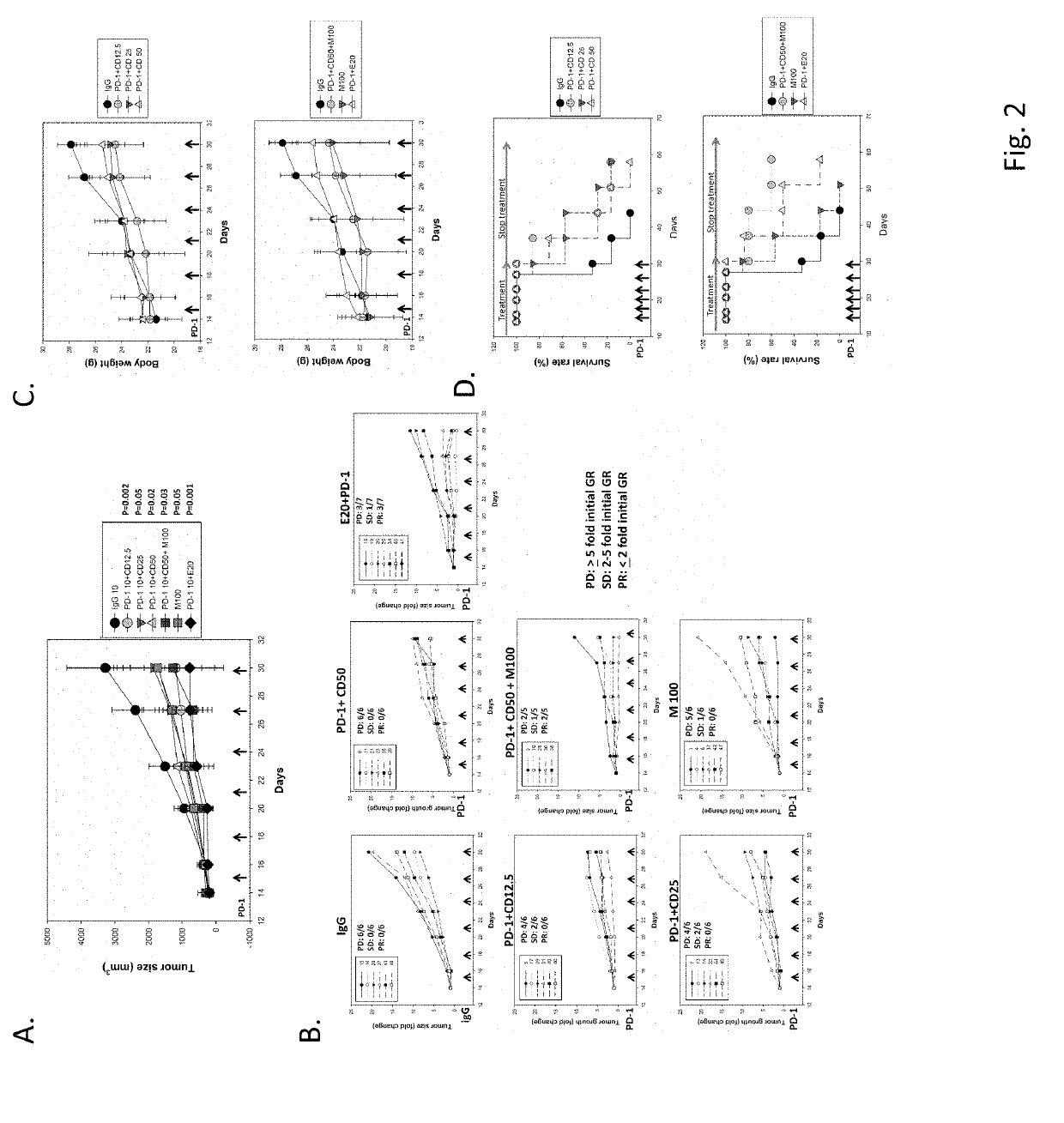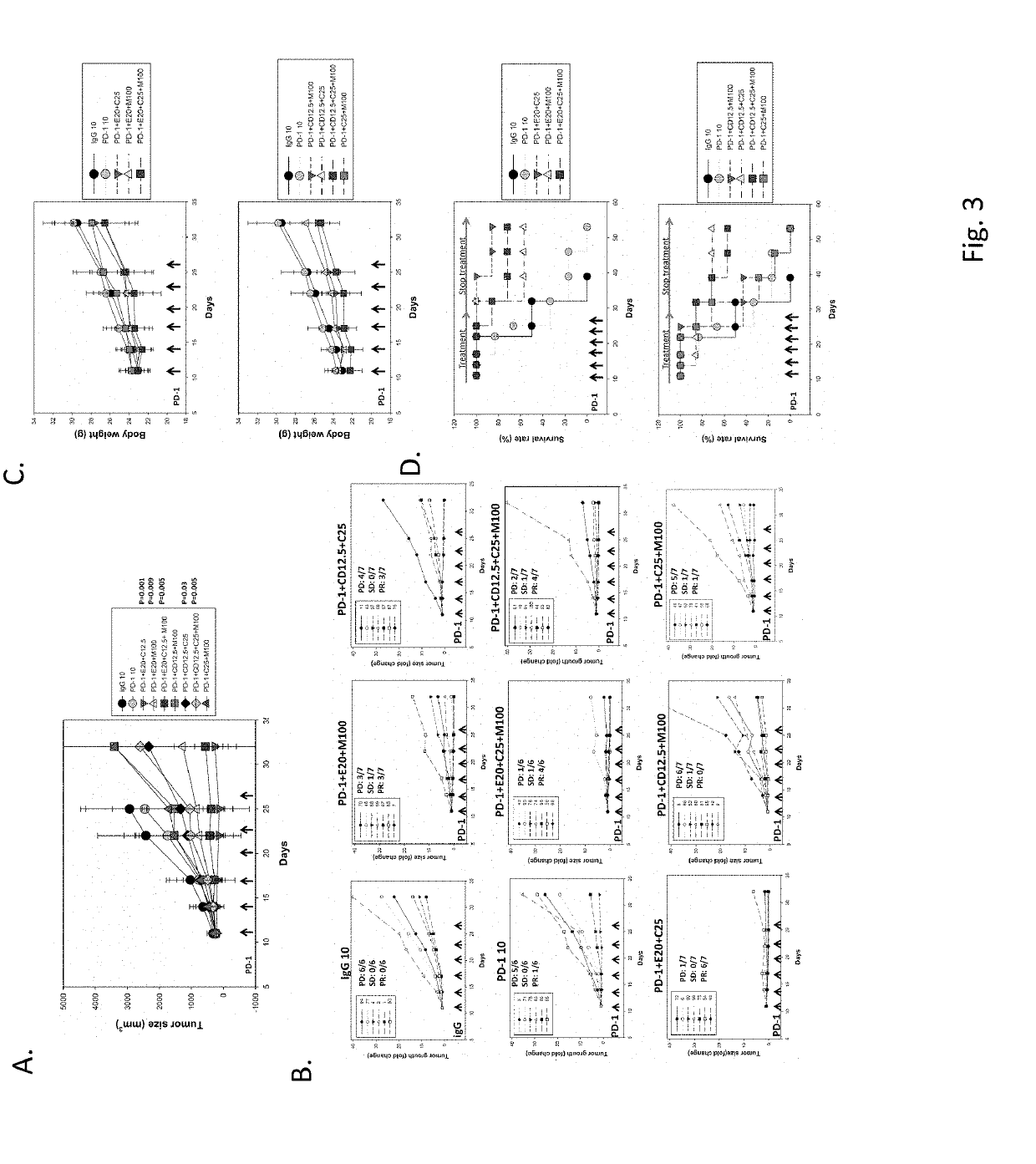Pharmaceutical combination and method for regulation of tumor microenvironment and immunotherapy
a tumor microenvironment and immunotherapy technology, applied in the field of immunotherapy, can solve the problems of unsatisfactory efficacy and inability to prevent immune escape, and achieve the effects of inhibiting tumor growth, potent anti-cancer activity, and inhibiting tumor growth
- Summary
- Abstract
- Description
- Claims
- Application Information
AI Technical Summary
Benefits of technology
Problems solved by technology
Method used
Image
Examples
example 1
Effects of Anti-PD-1 Antibody
[0074]To understand the anti-cancer activity of anti-PD-1 antibody on the CT-26 colon cancer cell -bearing BALB / c mice, the anti-PD-1 antibody was administered into CT26-bearing mice at 10 mg / kg of anti-PD-1 and / or anti-IgG antibodies i.p. on days 11, 14, 17, 20, 23, and 26 of post tumor implantation. The experiment was started when tumor size grew to approximately 200-300 mm3. The response rate was evaluated by several assays. In this study, we defined Partial Response (PR, 2 times tumor growth in the tumor bearing mice at the end of the treatment); Stable Disease (SD, between two and five times tumor growth in the tumor bearing mice at the end of the treatment); Progressive Disease (PD, equal to or greater than five times tumor growth in the tumor bearing mice at the end of the treatment). Normally, over ten to fifteen times tumor growth (about 3,000 mm3) was found in the control group. Anti-PD-1 antibody significantly inhibited tumor growth in compari...
example 2
Effects of Epigenetic Modulator Combined with Anti-PD-1 Antibody
[0075]The anti-cancer activity of chidamide or entinostat in combination with anti-PD-1 antibody was evaluated in CT26 tumor cells bearing mice. The chidamide or entinostat were orally administered to CT26-bearing mice at a dose of 25 mg / kg and 20 mg / kg, respectively. Chidamide was administered daily and entinostat was administered every two days. Chidamide or entinostat combined with anti-PD-1 antibody exhibited more potent anti-cancer activity than anti-PD-1 antibody alone (FIG. 1A). Chidamide combined with the anti-PD-1 antibody was more effective in inhibiting tumor growth than chidamide alone. Our results show that one mouse achieved PR, SD was observed in three mice, and PD was observed in one mouse in the group of chidamide in combination with anti-PD-1 antibody (FIG. 1B). However, the entinostat combined with anti-PD-1 antibody group shows more potency in inhibiting tumor growth than the chidamide combined with ...
example 3
Effects of Chidamide Combined with Metformin and Anti-PD-1 Antibody
[0076]100 mg / kg of metformin was orally administered to tumor bearing mice. The results show that the tumor growth was markedly inhibited in comparison with control group (see FIG. 2A). In the metformin group, SD was observed in one mouse and PD was observed in five mice (FIG. 2B). In the entinostat combined with anti-PD-1 antibody group (positive control), three mice achieved PR, SD was observed in one mouse and PD was observed in three mice (FIG. 2B). As shown in FIG. 2A, a higher dose (50 mg / kg) of chidamide combined with anti-PD-1 antibody has lower anti-cancer activity than a low dose (12.5 mg / kg) of chidamide combined with anti-PD-1 antibody. The treatment with chidamide at 12.5 mg / kg combined with anti-PD-1 antibody was more potent in inhibiting tumor growth than chidamide at 25 or 50 mg / kg combined with anti-PD-1 antibody (FIG. 2B). In the 12.5 mg / kg chidamide combined with anti-PD-1 antibody group, SD was ob...
PUM
| Property | Measurement | Unit |
|---|---|---|
| Fraction | aaaaa | aaaaa |
| Fraction | aaaaa | aaaaa |
| Fraction | aaaaa | aaaaa |
Abstract
Description
Claims
Application Information
 Login to View More
Login to View More - R&D
- Intellectual Property
- Life Sciences
- Materials
- Tech Scout
- Unparalleled Data Quality
- Higher Quality Content
- 60% Fewer Hallucinations
Browse by: Latest US Patents, China's latest patents, Technical Efficacy Thesaurus, Application Domain, Technology Topic, Popular Technical Reports.
© 2025 PatSnap. All rights reserved.Legal|Privacy policy|Modern Slavery Act Transparency Statement|Sitemap|About US| Contact US: help@patsnap.com



